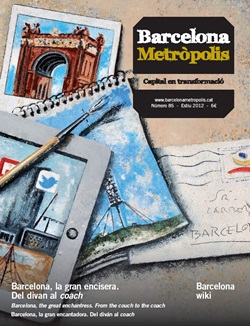Barcelona Metròpolis is entering a new era with a renewed purpose: to show the city the way it really is; a capital that pushes and pulls, that leads the country and journeys alongside it, that gets its energy from it but also puts its critical mass at the service of that country, unconditionally. Barcelona Metròpolis intends to bear witness to how the city aims to meet these obligations inherent in its position as a capital: evolving, adapting and improving. That’s why we speak of a capital in transformation. We all agree that in recent decades, Barcelona has worked hard to be where it is. The city has climbed the ranking of cities, it has attracted positive attention from the eyes of the world and it has consolidated its own brand name, which is currently better known than the name of Catalonia and much more sought-after than that of Spain. The Olympic Games put us on the map long before smartphones got us obsessed with geolocation. The Olympic aura and Gaudí’s legacy are two ingredients of an internationally recognised glamour that has grown in recent years thanks to the success of factors such as Barça, the Mobile World Congress and the export of Catalan cuisine.
All this prestige does not mean we can rest on our laurels. We live in a time of turmoil that is forcing us to re-position ourselves in ever-widening circles: in Catalonia, on the Iberian Peninsula, in the Mediterranean region, in Europe and in the World. Barcelona is not just the nucleus of a metropolitan area; it is the capital of a country that extends beyond its industrial outskirts. Given the choice between a Barcelona that feeds only on momentum and complacency and a Barcelona that integrates the living forces of Catalonia and opens them up to the rest of the world, we will always go for the second option. Today, Barcelona is a magnet not just in Catalonia but in an entire urban corridor or mega-region that fully integrates Catalonia. That is why Barcelona Metròpolis aims to openly show the world Barcelona’s Catalan identity.
Practically everyone now realises that the world has changed and nothing will ever be the same again. For many years, Barcelona was a city under construction, permanently inconvenienced by building works after decades of involuntary paralysis dating back to the post-Civil War period. It has undoubtedly undergone a period of real estate growth that has ended up colliding with its own limitations. We have discovered too late that construction was not synonymous with unlimited growth, or with creativity. From now on, you can be sure that it will be creativity that will allow us to function and give us visibility in a multipolar world.
In its previous phase, this magazine has contributed positively to urban thinking, to critical analysis of the city models that we have tried out, put into practice and consolidated. In this new phase, Barcelona Metròpolis proposes that we refocus discussions along three lines: where we come from, where we are and where we’re going. By asking these three Ignatian questions we can work out, in each case, if what is pushing us along is the result of a momentum that started in the past or a present-day impetus.
Barcelona Metròpolis will continue to be a quarterly magazine, and will now be published in a single trilingual edition. The remit of Bernat Puigtobella, the new Editor, is to bring the magazine to people, from here and elsewhere, who did not previously read it. This also involves giving a platform to the younger generation, young people who were born just before or just after the Olympic Games, who will be the real players in the Barcelona that we are creating today. With this purpose of making the content more accessible, we have also overhauled the website. By doing so, we have given a boost to the magazine’s digital edition, which is now more dynamic and better connected to the social networks, particularly Twitter, where Barcelona Metròpolis already has over a thousand followers. Digitalisation will also allow readers to look up back issues. Above all, it also opens up the possibilities of reader participation. Barcelona Metròpolis invites the public to have their say, to express their self-esteem without falling into complacency and without losing their critical thinking. A capital in transformation must be open to participation, so that it learns how to transform and how to really be a capital.




